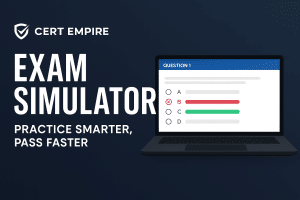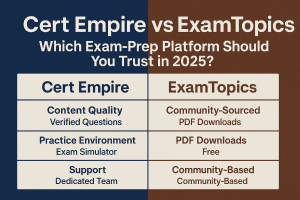The CISSP exam is one of the most comprehensive and challenging certification exams in the cybersecurity industry. With its broad scope covering eight domains, it’s easy to make mistakes during preparation and on exam day. However, being aware of common mistakes and how to avoid them can significantly increase your chances of success.
In this blog, we’ll discuss the most common CISSP exam mistakes candidates make and provide practical tips on how to avoid them. Whether you’re preparing for the exam or planning your study strategy, this guide will help you stay on track and approach the test with confidence.
TLDR: Too Long; Didn’t Read
Many CISSP candidates make common mistakes during their preparation, such as neglecting certain domains, relying too heavily on practice exams, or not managing time effectively during the test. To avoid these errors, focus on understanding core concepts, manage your study time wisely, practice using real exam questions, and stay calm during the test. By addressing these mistakes, you’ll be better prepared for success.
Common CISSP Exam Mistakes and How to Avoid Them
Here are the most common CISSP exam mistakes and the strategies you can use to avoid them:
1. Skipping Over Certain Domains
One of the most common mistakes is skipping or spending too little time on certain CISSP domains that you might find less interesting or more challenging. Every domain is important, and neglecting any one of them can negatively affect your score.
Mistake: Skipping or rushing through domains like Software Development Security or Asset Security because they may seem less practical or harder to grasp.
How to Avoid It:
- Review the Exam Outline: The CISSP exam covers eight domains, and each one is important. Use the exam outline to identify key areas of focus.
- Don’t Skip the Weak Areas: Even if a domain feels challenging, tackle it head-on. Use additional resources like video courses, study guides, and practice questions to understand tough topics.
- Prioritize: Allocate study time based on the weight of each domain. For example, Security and Risk Management carries a higher weight, so ensure you dedicate enough time to it, but don’t ignore the smaller domains.
Why This Matters:
Each domain is a crucial part of the CISSP exam. A balanced approach to studying ensures you’re well-prepared for the full breadth of the material.
Top CISSP Exam Mistakes and How to Avoid Them
| Common Mistake | Impact on Score | How to Avoid |
| Skipping certain domains | Lowers overall weighted score | Follow a balanced study plan; cover all eight domains thoroughly. |
| Over-reliance on practice questions | Leads to shallow understanding | Use practice exams for assessment only; focus on concept mastery. |
| Poor time management | Incomplete exam, rushed answers | Simulate timed tests and pace each question carefully. |
| Ignoring question formats | Confusion with drag-and-drop or hotspot questions | Practice with mixed-format question banks and simulators. |
| Last-minute cramming | High stress, memory gaps | Stick to a gradual study schedule; focus on light review in the final week. |
2. Relying Too Much on Practice Exams
Practice exams are valuable tools, but relying too heavily on them without truly understanding the underlying concepts is a mistake that many candidates make.
Mistake: Taking practice exams repeatedly without reviewing the correct answers or understanding why certain answers were wrong.
How to Avoid It:
- Use Practice Exams Strategically: Practice exams are best used to gauge your understanding of the material and familiarize yourself with the exam format. Use them after studying to assess your knowledge and to identify weak areas.
- Review Your Mistakes: When you miss a question, take the time to understand why you got it wrong. This will help reinforce your knowledge and prevent similar mistakes on the actual exam.
- Don’t Focus Only on the Questions: While practice exams are helpful, they should complement in-depth study. Ensure you understand the concepts behind the questions rather than just memorizing answers.
Why This Matters:
Practice exams are a tool for testing your knowledge, not a replacement for studying. They should be used as a supplement to your learning process.
3. Not Managing Time During the Exam
Time management is critical during the CISSP exam. The exam is long, and the questions are designed to test your ability to think critically and apply knowledge under pressure.
Mistake: Spending too much time on difficult questions and running out of time to complete the exam.
How to Avoid It:
- Practice Time Management: Use practice exams to simulate real exam conditions. Set a timer and practice answering questions under time pressure.
- Skip and Return: If you’re stuck on a question, skip it and move on. You can come back to it later if you have time.
- Allocate Time Based on Question Weight: Focus more time on high-weight domains (like Security and Risk Management) and quicker, easier questions.
Why This Matters:
Proper time management ensures that you can answer all questions within the allotted time. Don’t let difficult questions waste time that could be spent on easier ones.
4. Not Understanding the Question Formats
The CISSP exam includes a variety of question formats, such as multiple-choice, drag-and-drop, and hotspot questions. Not understanding how to approach these different types of questions can lead to confusion and mistakes.
Mistake: Not being familiar with the different question types and their formats, which leads to confusion during the exam.
How to Avoid It:
- Familiarize Yourself with the Question Formats: Take time to practice with drag-and-drop and hotspot questions, as they can be tricky if you’ve never encountered them before.
- Understand the Question Style: For example, drag-and-drop questions often require you to order items, while hotspot questions involve selecting areas of a diagram. Each type of question has its own strategy.
- Practice All Formats: Use CISSP exam simulators to get comfortable with all types of questions. This will help you understand how to approach them during the real exam.
Why This Matters:
Being prepared for the variety of question formats helps you stay calm and collected during the exam, enabling you to answer each question efficiently.
5. Overloading Yourself with Last-Minute Studying
Many candidates make the mistake of trying to cram all the material into the final days before the exam. While last-minute review is important, it’s not a substitute for a well-structured study plan.
Mistake: Trying to cram all the material in the final days or hours before the exam, leading to stress and confusion.
How to Avoid It:
- Study Consistently: Start your preparation months in advance. Break down the material into manageable chunks, and study consistently over time.
- Use the Final Week for Review: In the last week before the exam, focus on reviewing key concepts and practice questions rather than trying to learn new material.
- Relax Before the Exam: Ensure you’re well-rested before the exam day. Mental clarity is essential for performing well on the test.
Why This Matters:
Cramming at the last minute can lead to stress and poor performance. Consistent study and a relaxed mind will help you perform better on exam day.
Last-Week CISSP Prepartion Checklist
| Day Range | Key Actions | Purpose |
| 7–5 Days Before | Take two full-length practice exams | Final performance check and timing practice |
| 4–3 Days Before | Review weak domains, revise flashcards | Close remaining knowledge gaps |
| 2 Days Before | Light reading of key frameworks (NIST, ISO) | Strengthen understanding of high-weight areas |
| Day Before | Rest, organize documents, and test-center plan | Ensure mental freshness and stress-free exam day |
Quick Summary
Common CISSP exam mistakes include skipping domains, relying too much on practice exams, poor time management, not understanding question formats, and last-minute cramming. Avoid these by reviewing all domains thoroughly, practicing time management, understanding all question types, and following a structured study plan.
Final Thoughts
The CISSP exam is undoubtedly challenging, but avoiding these common mistakes can significantly improve your chances of success. By managing your time effectively, studying all domains, and using practice exams wisely, you’ll be well-prepared for exam day. Remember, consistency and preparation are key to passing the CISSP exam.
More Resources
For more insights on how to prepare for the CISSP exam, visit the CISSP complete preparation insights.
Check out these related blogs for additional guidance on your CISSP journey:
- CISSP Exam Day: What to Expect and How to Prepare
- CISSP Retake Policy: What Happens if You Don’t Pass the Exam?
Last Updated on by Team CE



























